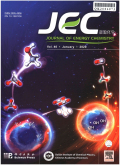- 钛学术文献服务平台 \
- 学术期刊 \
- 工业技术期刊 \
- 石油与天然气工业期刊 \
- 能源化学期刊 \
One stone two birds:Dual-effect kinetic regulation strategy for practical lithium-sulfur batteries
One stone two birds:Dual-effect kinetic regulation strategy for practical lithium-sulfur batteries
基本信息来源于合作网站,原文需代理用户跳转至来源网站获取
摘要:
Lithium-sulfur (Li-S) batteries are deemed as one of the most promising energy storage systems due to their ultrahigh theoreti-cal energy density of 2600 Wh kg-1 far beyond the current lithium-ion battery technique [1].Generally,the sulfur redox reac-tions undergo complex conversion processes between solid sulfur(S8),soluble lithium polysulfides (LiPSs,Li2Sn,4 ≤ n ≤ 8),and solid lithium sulfide (Li2S) to afford high specific capacity of 1672 mAh g-1 [2,3].However,the sluggish kinetics of the above-mentioned multi-electron and multi-phase sulfur redox reactions [4,5] seri-ously hinder the actual battery performances regarding poor rate responses,low Coulombic efficiency,and limited cycling lifespan[6,7].Worse still,the formation of LiPS clusters under practical working conditions such as under lean electrolyte or varied tem-peratures further aggravates the sulfur redox kinetics severely[8,9].Hence,approaches to regulate the properties of LiPSs are essential for high performance Li-S batteries.

推荐文章
The influence of urbanization on karst rivers based on nutrient concentration and nitrate dual isoto
Urbanization
Urban river
Nitrate isotopes
Southwestern China
Chengguan River
Effect of Zn deficiency and excessive bicarbonate on the allocation and exudation of organic acids i
Adaptation
Excessive bicarbonate
Organic acids
Organs
Root exudates
Zn deficiency
一种基于XML的One to One营销优化建模方法
One to One营销优化模型
XML
DOM
自定义建模
Sulfate sources constrained by sulfur and oxygen isotopic compositions in the upper reaches of the X
Sulfur isotope
Oxygen isotope
Riverine sulfate
Carbonate weathering
Xijiang River
内容分析
关键词云
关键词热度
相关文献总数
(/次)
(/年)
引文网络
引文网络
二级参考文献 (0)
共引文献 (0)
参考文献 (0)
节点文献
引证文献 (0)
同被引文献 (0)
二级引证文献 (0)
2022(0)
- 参考文献(0)
- 二级参考文献(0)
- 引证文献(0)
- 二级引证文献(0)
引文网络交叉学科
相关学者/机构
期刊影响力
能源化学
主办单位:
中国科学院大连化学物理研究所
中国科学院成都有机化学研究所
出版周期:
双月刊
ISSN:
2095-4956
CN:
10-1287/O6
开本:
出版地:
大连市中山路457号
邮发代号:
创刊时间:
语种:
eng
出版文献量(篇)
2804
总下载数(次)
0
总被引数(次)
7996
期刊文献
相关文献
推荐文献
- 期刊分类
- 期刊(年)
- 期刊(期)
- 期刊推荐
一般工业技术
交通运输
军事科技
冶金工业
动力工程
化学工业
原子能技术
大学学报
建筑科学
无线电电子学与电信技术
机械与仪表工业
水利工程
环境科学与安全科学
电工技术
石油与天然气工业
矿业工程
自动化技术与计算机技术
航空航天
轻工业与手工业
金属学与金属工艺
能源化学2022
能源化学2021
能源化学2020
能源化学2019
能源化学2018
能源化学2017
能源化学2016
能源化学2015
能源化学2014
能源化学2013
能源化学2012
能源化学2011
能源化学2010
能源化学2009
能源化学2008
能源化学2007
能源化学2006
能源化学2005
能源化学2004
能源化学2003
能源化学2002
能源化学2001

 免费查重
免费查重










